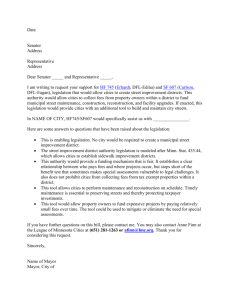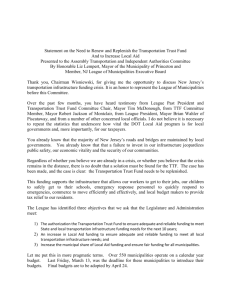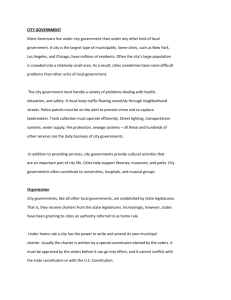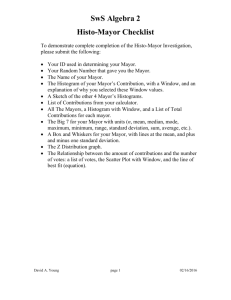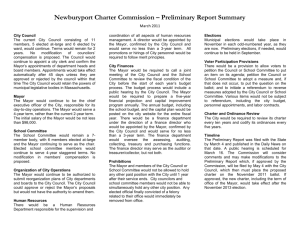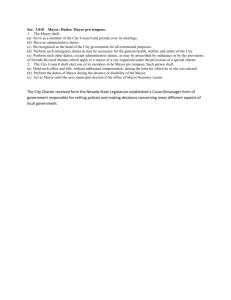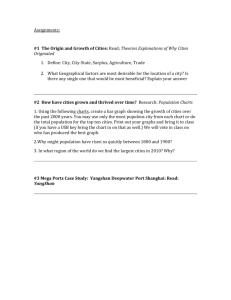municipal government
advertisement
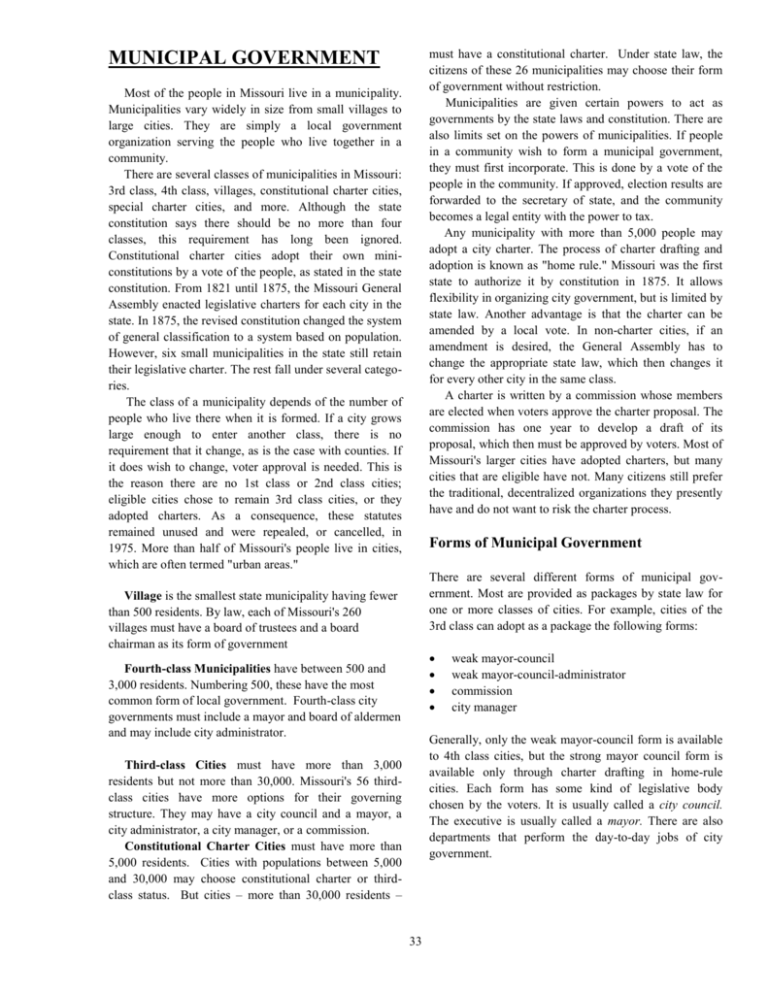
must have a constitutional charter. Under state law, the citizens of these 26 municipalities may choose their form of government without restriction. Municipalities are given certain powers to act as governments by the state laws and constitution. There are also limits set on the powers of municipalities. If people in a community wish to form a municipal government, they must first incorporate. This is done by a vote of the people in the community. If approved, election results are forwarded to the secretary of state, and the community becomes a legal entity with the power to tax. Any municipality with more than 5,000 people may adopt a city charter. The process of charter drafting and adoption is known as "home rule." Missouri was the first state to authorize it by constitution in 1875. It allows flexibility in organizing city government, but is limited by state law. Another advantage is that the charter can be amended by a local vote. In non-charter cities, if an amendment is desired, the General Assembly has to change the appropriate state law, which then changes it for every other city in the same class. A charter is written by a commission whose members are elected when voters approve the charter proposal. The commission has one year to develop a draft of its proposal, which then must be approved by voters. Most of Missouri's larger cities have adopted charters, but many cities that are eligible have not. Many citizens still prefer the traditional, decentralized organizations they presently have and do not want to risk the charter process. MUNICIPAL GOVERNMENT Most of the people in Missouri live in a municipality. Municipalities vary widely in size from small villages to large cities. They are simply a local government organization serving the people who live together in a community. There are several classes of municipalities in Missouri: 3rd class, 4th class, villages, constitutional charter cities, special charter cities, and more. Although the state constitution says there should be no more than four classes, this requirement has long been ignored. Constitutional charter cities adopt their own miniconstitutions by a vote of the people, as stated in the state constitution. From 1821 until 1875, the Missouri General Assembly enacted legislative charters for each city in the state. In 1875, the revised constitution changed the system of general classification to a system based on population. However, six small municipalities in the state still retain their legislative charter. The rest fall under several categories. The class of a municipality depends of the number of people who live there when it is formed. If a city grows large enough to enter another class, there is no requirement that it change, as is the case with counties. If it does wish to change, voter approval is needed. This is the reason there are no 1st class or 2nd class cities; eligible cities chose to remain 3rd class cities, or they adopted charters. As a consequence, these statutes remained unused and were repealed, or cancelled, in 1975. More than half of Missouri's people live in cities, which are often termed "urban areas." Forms of Municipal Government There are several different forms of municipal government. Most are provided as packages by state law for one or more classes of cities. For example, cities of the 3rd class can adopt as a package the following forms: Village is the smallest state municipality having fewer than 500 residents. By law, each of Missouri's 260 villages must have a board of trustees and a board chairman as its form of government Fourth-class Municipalities have between 500 and 3,000 residents. Numbering 500, these have the most common form of local government. Fourth-class city governments must include a mayor and board of aldermen and may include city administrator. weak mayor-council weak mayor-council-administrator commission city manager Generally, only the weak mayor-council form is available to 4th class cities, but the strong mayor council form is available only through charter drafting in home-rule cities. Each form has some kind of legislative body chosen by the voters. It is usually called a city council. The executive is usually called a mayor. There are also departments that perform the day-to-day jobs of city government. Third-class Cities must have more than 3,000 residents but not more than 30,000. Missouri's 56 thirdclass cities have more options for their governing structure. They may have a city council and a mayor, a city administrator, a city manager, or a commission. Constitutional Charter Cities must have more than 5,000 residents. Cities with populations between 5,000 and 30,000 may choose constitutional charter or thirdclass status. But cities – more than 30,000 residents – 33 The most common type of government is the mayorcouncil form. More than 75 percent of all the municipalities in Missouri use mayor-council organization. There are two basic types: one is called "weak," and the other is termed "strong." The weakness or strength is determined by how much appointive authority the mayor has. This means: Does the mayor get to appoint the police chief or other department heads, or are they elected? Does he or she have to share this appointive authority with the council? The weak mayor-council form has the voters electing a council, a mayor, and a number of other officials. These may include a city attorney, tax collector, marshal, treasurer, assessor, and others. Some other officials may be appointed by the council; others are appointed by the mayor with the approval of the council. The mayor has little real power to act as an executive in the city. The result is that no one can be held responsible for what happens in the city government. It is difficult for one elected official to supervise another. Some people may be given jobs for political reasons in this form of government. More than half of the municipalities in our state have a weak mayor-council government. This is because the state law requires many municipalities to have several elected officials instead of appointed ones. The strong mayor-council form puts more power in the hands of the mayor. This form, however, is available only to home rule charter cities. In this form, voters choose or elect fewer officials. The voters select a mayor and a council called a board of aldermen. Voters may elect a few other officials, or they may be appointed by the mayor. The mayor is then allowed to appoint most executive officials such as the assessor, city attorney, tax collector, clerk, and street commissioner. The board of aldermen may provide for the election of these officials. This form of government must be approved by the voters. Small towns or villages have another form of municipal government. Here the voters elect a council called a board of trustees. The board chooses a chairman and appoints all other city officials, including a marshal, tax collector, and treasurer. Another type of organization that may be adopted is called the city administrator form. It retains the decentralized weak mayor form, but allows the mayor and council to appoint a city administrator. The city administrator works on authority delegated by the mayor. This form has become increasingly popular because it retains the traditional weak mayor structure while providing for professional management. This can be done by ordinance rather than election, which makes abandonment easy. The other professional management structure, the city manager form, must be approved in a citywide election and retained for at least six years. Many city populations oppose the city manager form as being dictatorial. The total number of municipalities with city managers has remained almost constant for decades. In contrast, city administrator communities are increasing and have more than doubled the number of manager cities. The city council form of city government is used in more than 30 cities, but must be approved by the voters before it can be used. The voters elect a council and a mayor. The council members then choose a clerk, assessor, treasurer, and a manager. This council determines the policies to be followed by the city and approves the budget. The manager is trained in running the day-to-day business of the city and makes recommendations for action to the council. The manager may be fired by the council if a majority of the council members do not like his or her work. The manager appoints all other officials in the city government. One advantage of this form of government is that patronage is less likely. Patronage is appointing political friends to jobs in government. As a result, those who run the city's business are professionals at their jobs, due to the merit system. A very different form of government called the commission form may also be used. Voters elect the mayor and council members in an at-large election; that is, all voters in the city vote for all members of the council. The council is called a commission and each member of the commission heads at least one department of the city. The mayor also heads a department, usually the department of public affairs. Fewer than ten municipalities in Missouri use this form of government. It also requires that the elected commissioners be good administrators. A person may do a good job at representing the voters and not be a good executive. SPECIAL DISTRICTS Special districts are units of local government that are separate from municipalities or counties. They usually perform one kind of service. These districts may cross the boundaries of both cities and unincorporated areas. Special districts handle such services as fire protection, sewers, storm drainage, and education. They are created because some other kind of government is not meeting a need of the people. Special districts usually have an elected governing body. People often know very little about these groups; thus, voter turnout at their elections may be very low. Such districts have the power to set their own taxes and make some rules. 34 who buys a school bond is lending money to the school district at a fixed interest rate. Education takes a large percent of all the money spent by state and local government. The governing board also hires a superintendent to run the day-to-day business of the district. This person carries out the decisions of the board and recommends actions to it, but serves at the pleasure of the board. The superintendent appoints school principals and other district officials. Each school has a principal, often some assistant principals, and staff. The staff may consist of teachers, counselors, a nurse, bus drivers, and custodians. School Districts Public schools in Missouri are run by local school districts. There are more than 550 such districts in our state. Some provide education for kindergarten students through the 12th grade. Others may serve only through grades 6 or 8. State law sets some rules to be followed by school districts. There is a state board of education that helps administer those rules. The members of this board are appointed by the governor and confirmed by the Senate. The state board appoints a commissioner of education to administer the state department of education. Local school districts have the power to actually run the schools. Each district covers a fairly small area. A governing board is elected by the voters of the district. These boards may have between 6 and 12 members elected for three-year terms. The governing board sets the policies to be followed in the district. The board sets a property tax to help pay for the cost of public schools. This local tax, plus county money, totals about 35 percent of what is spent for education. The state government provides more than 40 percent of the money for school districts, and the rest of the money comes from the federal government and a special sales tax. Bonds may be sold by the district to construct buildings. A bond is simply a promise to pay back borrowed money at a certain rate of interest. A person SUMMARY Local government has more to do with our daily lives than any other form of government. It provides services that we count on every day, yet most people seem to pay little attention to it. Far fewer voters take part in local elections than in national elections. There are many kinds of local governments. They include counties, different kinds of municipalities, and different kinds of special districts. The basic rules for creating and running these forms of government are set by the state. Each has some power to set its own rules within these guidelines. Voters usually have the chance to choose the legislative body of the local government. Some local governments have other elected officials as well. 35
